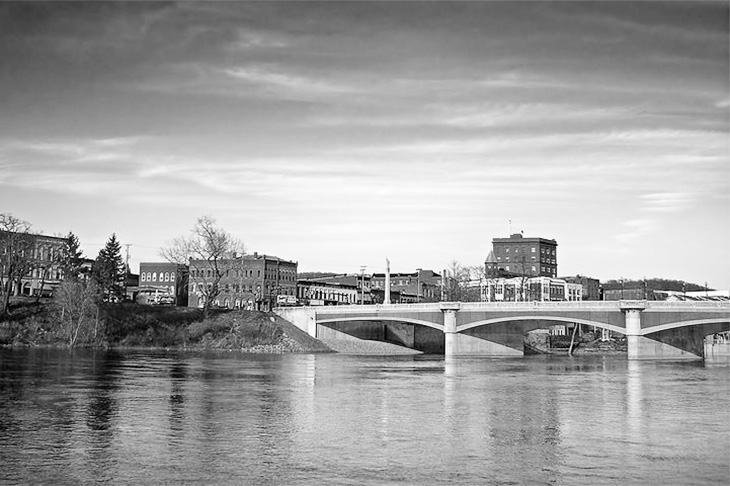‘Where are you from?’ is a question I’ve always hated to answer. My friends — minus the poor bastards I grew up with — can say Queens or Memphis or Houston, names that imply a certain breadth and depth of clay-shaping experience. They can say Olathe, Kansas or Lawton, Oklahoma, and evoke Terrence Malickian expanses of wheat, a golden monotony bordering on the sublime. They can say Miami, and everyone feels like dancing.
Say ‘Connecticut,’ as I do, and you hear crickets. Which, lest you misunderstand, isn’t because our crickets are anything special.
That Connecticut does have attributes, for lack of a more exciting way to put it, is an argument for another day. To most people, Connecticut is boring, featureless, the J. Crew of US states. Even its beautiful, rural northern part, where I grew up, and its beautiful, coastal southern part, where I’ve lived, look more like the stock photography in a promo calendar than like a place with actual character.
So, like a counterfeit wine label, I lie about my terroir. I’ve claimed to be from Pennsylvania, to have lingering if unsubtle notes of anthracite coal and Bethlehem steel, and an impertinent bouquet of Cheez Whiz. That isn’t quite false. Pennsylvania is my point of origin: I was born there — identity thieves take note — in Warren, Pennsylvania, forty miles southwest of Salamanca, New York. Yet we moved away by the time I was two, and it didn’t occur to me to visit Warren, until this morning, when I woke up in Salamanca.
I left Salamanca, sleep-deprived and hungry, feeling little better than the dead porcupine I saw scattered like a box of toothpicks across a reservation road. Under gray skies I passed by, or through, barely-there Red House, New York (joë’hesta in Seneca) which, as of the 2010 census, was the least-populous place in the state, with 38 souls. Stopping at a store for a snack, I found only row upon row of generic cigarettes, some of them packaged loose in clear plastic bags.
‘Nobody on this stretch has any brands,’ a woman warned me. ‘Just so you’re not wasting your time.’
The whole place had an off-brand feel. A church said EST 33 A.D., with no further clue to its denomination. The houses, though they weren’t without charm, resist description. The woods themselves seemed to have been purchased at a hobby shop, to decorate a model train board. I’m so boring, I thought in despair, that I pretend to be from a place more boring than the one I’m from.
That, of course, was historically illiterate nonsense. Not far from Warren, Pennsylvania, in whose hospital I entered this world, there is a structure called the Kinzua Dam, built by the Army Corps of Engineers between 1960 and 1965. The Kinzua Dam and its half a million cubic yards of concrete are the sort of details that, were I traveling in a hurry, I’d note on a map and promptly forget. But now that I have time to investigate my surroundings, my interest in civil engineering is blooming.
The Corps of Engineers’s webpage on the Kinzua Dam mentions in passing that ‘the Seneca Indians have a long and rich history in the area’. For a sense of just how euphemistic that statement is, the reader is directed to Edmund Wilson’s Apologies to the Iroquois (1960). Part of the Senecas’ long and rich history in the area was having a huge tract of their arable land annexed and flooded to create the Allegheny Reservoir. Not only were hundreds of living Seneca displaced — some 600 families — but also the remains of many Seneca had to be exhumed and moved, including the famous Senecan diplomat John ‘Cornplanter’ Abeel. Johnny Cash even recorded an excruciating protest song about it, ‘As Long as the Grass Shall Grow’, on his 1964 album Bitter Tears: Ballads of the American Indian. But that, like a burial ground, is better left undisturbed.
Wilson’s book illuminates the Indian nationalist and religious movements of its day, and is a careful inquiry into what it means to really be from somewhere, to be tied intimately to the land. It raises still-urgent questions about liberty and state power. In 1958, Wilson, telling to John Dos Passos of his investigations into the Indians and the ‘big power projects’, wrote, ‘It is appalling to see how much this country is getting to be run by engineers, bureaucrats, and the Armed Forces.’ The land, Wilson believed, should belong to those who love it best — an unsettling jab, perhaps, at those of us who lack deep roots.
I certainly felt no sense of homecoming in Warren, not even on the front lawn of my first childhood home. I saw a man my age in a McDonald’s parking lot, limping, scowling, pale, in a black tracksuit and an eye patch. Is this what I’d have become had my family stayed here? It doesn’t bear thinking about. It was, by the way, on the pretext of protecting Warren from flooding that the Kinzua Dam was initially proposed. According to Edmund Wilson, it was a particularly costly contrivance intended to serve the interests of a group of industrialists in Pittsburgh . . . [who] have their reasons for wanting the river diluted at the seasons when it is running low’.
So, if anybody asks, I guess I’m from Connecticut.
Westering is the travel diary of critic and essayist Stefan Beck, who would otherwise be living in Hudson, NY.

























